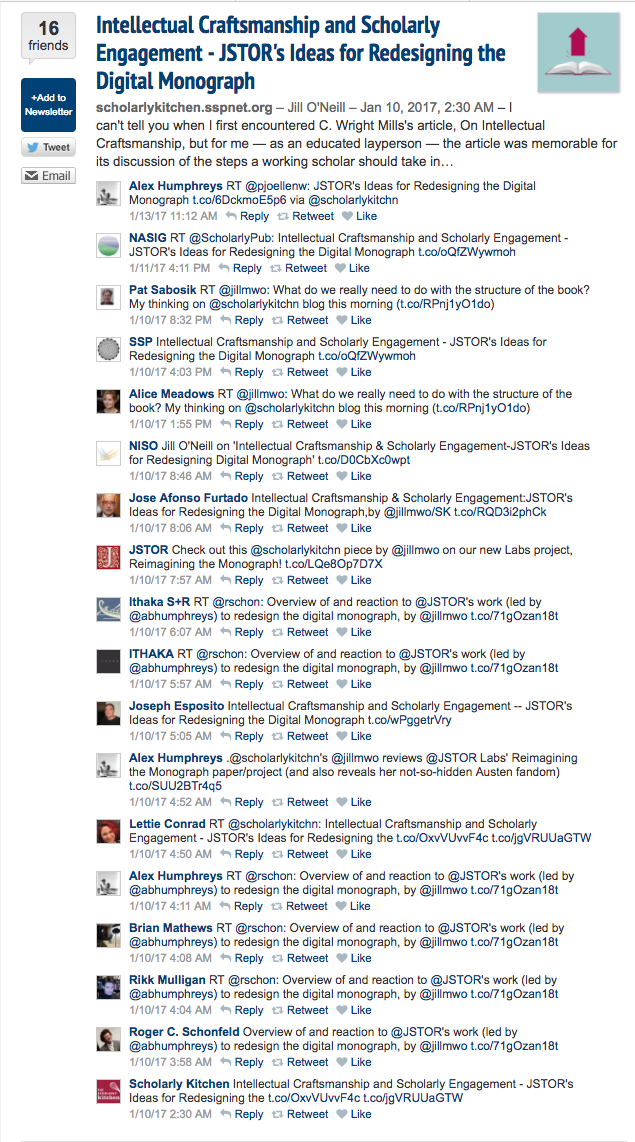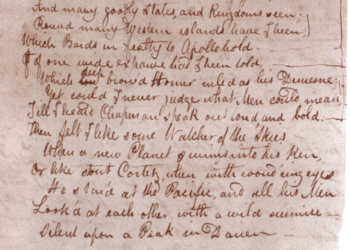There’s no doubt that Twitter has its issues as a business. It has lost key C-level executives as well as key high-profile users. Analysts are considering downgrading the value of the company’s stock. At the same time, it appears to be the preferred broadcast tool of the 45th President of the United States. Twitter is undeniably useful for purposes of disseminating one’s message to a mass audience; Nuzzel is just one of the latest mechanisms for eliminating distractions from a Tweet stream while enhancing the platform’s value in dissemination of credible journalism.
Nuzzel is a tool that allows the user to focus in on linked, full-text articles shared within his or her Twitter network during a particular time frame. The interface displays the tweeted headline (linked to the original host site) followed by the content of the tweets emanating from my network. I can still reply to, retweet, or “heart” those tweets, just as if I were accessing Twitter directly. In addition, Nuzzel will even show me if there’s ongoing discussion of the article on sites such as Reddit, Hacker News, and TechMeme.
What does it weed out from my tweet stream? PR announcements that might refer the recipient to event sites or unvetted press releases. Tweets with animated GIFs. Tweets featuring embedded pull quotes as screenshots or images from Instagram (and sadly, under that same algorithmic rule, cartoons from The New Yorker). The application’s key function is to surface full-text articles from original sources via linked headlines. Nuzzel appears to have some mechanism for knowing when a shortened URL points back to the primary host, although it appears that’s true only for those using Twitter’s proprietary tool for that purpose. The approach emphasizes the original source publication, but not the platform. Content published solely to the Web is as eligible as content found in both print and digital environments.
I’ve used the app for 12 weeks, and the rationale behind it strikes me as sound. Reviewing a tweet stream on a mobile phone locks the user into a single linear chronology (most recent being at the top) and there is an increasing amount of advertising (“promoted tweets”). In 2009, Twitter implemented lists as its internal mechanism for slicing and dicing a user’s stream in support of a focused scan, and this approach has not been noticeably enhanced in the meantime. Lists still restrict the user to viewing a feed in reverse chronological order. Nuzzel’s interface allows the user to see those items or to view articles most frequently tweeted by those you follow within a specific time frame (the past four hours, eight hours, 24 hours, last Wednesday, etc.). The system defaults to a 24-hour window. If a particular news story has gained massive traction within the specified time frame, that is obvious at a glance. Any user who has honed his or her network on Twitter to those whose contributions are most informative will get a huge boost in efficiency and understanding from using this app. And while I’ve not taken advantage of the option, it is also possible to harness in Nuzzel any professional network you’ve developed on Facebook.
The app has received backing from investors well known for their expertise in the news media business — professionals who have worked for The Wall Street Journal, Dow Jones, and the Guardian Media Group as well as the Knight Foundation.
A week after the post was created, Nuzzel could tell me at a glance that the link to my Scholarly Kitchen post, Intellectual Craftsmanship and Scholarly Engagement, was shared by 16 Twitter accounts on the Tuesday it went live; confined to the statistics provided by Twitter, I might have mistakenly thought that the dissemination of the link was lower than that, even though Twitter will tell me who “liked” the tweet I sent out with the SK link. Nuzzel recognizes more than the activity of retweeting; the system identifies and tracks the linked URL to an item and generates metrics based specifically on that URL. It does not matter whether the URL appears in the standard Scholarly Kitchen tweet sent out each morning or whether I embed the link into a tweet of my own crafting.
At the same time, one can see if there’s a bigger news story that is of greater concern to the network. For example, Crossref tweeted a link from its blog, explaining its guidelines for using the https protocol in conjunction with DOIs. The volume of dissemination surrounding that announcement in my feed meant that story was displayed below two other mainstream news stories attracting attention but, using Nuzzel, I could still immediately understand the importance of Crossref’s content to my network of professionals and use that to gauge whether I ought to be reading it as well.
I use either the Web-based version of Nuzzel or the iOS version; there is an Android version as well. While the iOS version may have the appeal of a sleeker design, in both versions the user experience and interface are immediately intuitive. It’s not just that I can choose to focus on what the folks I follow (librarians and content providers) are tweeting; Nuzzel also allows me to see what the “friends of friends” population are discussing. Another example: my immediate network may not have placed any particular emphasis on this piece, but their networks brought it forward as a useful item. There’s also an option simply entitled “News You May Have Missed,” generated, insofar as I can determine, by some volume of tweets from friends as well as those from friends of friends. For example, only two in my direct network may have tweeted the link to a Guardian story about a Hard Brexit, but five more in their extended networks felt it was worthy of note and so it appeared under the interface tab. In news media terminology, I would imagine such placement is akin to news stories that appear on internal pages, but still “above the fold” in order to catch the reader’s eye.
I can see immediate and significant value here for information professionals and scholars across a host of disciplines.
One useful tab appearing in the interface (for current awareness purposes) is the tab labeled “Recently Read Stories.” Given that my focus on Twitter tends to be information-gathering, I pursue a significant percentage of articles linked in tweets sent out by my network. This particular tab is useful when trying to track down an article I’ve previously encountered and accessed via Nuzzel. Further, the site is searchable—although it helps if one can recall key phrases from the particular headline. It should be noted that one can’t search using hashtags, nor is it possible to search for a particular Twitter handle. The tool is clearly geared to the purposes of news organizations, journalists, and those seeking authoritatively published and branded material.
That last phrase (“branded material”) is important. One aspect that Nuzzel appears to be pushing is the creation and dissemination of curated newsletters by its users. That brand may be a recognized journalist or industry specialist, such as Farhad Manjoo, Walt Mossberg, or Jose Afonso Furtado. Alternatively, it may be that of a well-known publication such as The Atlantic, The Wall Street Journal, The Verge, or TechCrunch. Somewhat buried under the “Newsletters” tab, one can view the primarily newspaper and magazine publications that are currently using the newsletter feature to spotlight the “Best of” — the top five stories of the day from their pages. While this offering undoubtedly aids in the shift away from email dissemination of content, it’s still something of an uphill slog to persuade readers to absorb one more newsletter. On the other hand, given the power of personal brands as well as the current emphasis on content curation, it may be that the newsletter approach will work for certain niche groups of readers — that is, those who are as apt to rely upon news tweeted by Marc Andreeson as from any publication of record.
That this app appeared in two news organizations’ Top Ten of 2016 may well have been (at least to some degree) a self-serving form of publicity. Nuzzel’s emphasis on published full text from original source publications and on associated headlines makes it clear that the media wants its value-add recognized when news is being disseminated globally in the space of 140 characters. The Nuzzel app was clearly designed by branded media organizations in the interest of re-focusing attention on those responsible for credible (if not always unbiased) reporting.
A smart Twitter user who follows researchers and practicing scientists could, using Nuzzel, easily and swiftly pick up on the hot articles that engender excitement. The fact that it can be used in conjunction with Slack indicates that it would readily fit into enterprise workflow. I can see immediate and significant value here for information professionals and scholars across a host of disciplines. We know that Twitter is useful for purposes of scientific dissemination, but that there’s insufficient proof of its contribution to citation activity. The linked article (hosted by the London School of Economics Impact blog) asks the very pertinent question, “To what extent are citations a reflection of research quality and novelty?” suggesting to me that the author believes some other indicator of active interest might more precisely meet scholarly needs.
There is substantive value in Nuzzel both for filtering information in a Tweet stream as well as for purposes of gauging the spread of authoritative content and knowledge. You owe it to yourself to experiment with it.
Discussion
4 Thoughts on "Have You Looked At This? Nuzzel.com"
I still don’t see how it follows that Nuzzel might “more precisely meet scholarly needs,” as your ending implies. Important/influential researcher finds article, includes it in newsletter, followers see it more often, and then what? I guess I’m just wary of yet another service that promises it’s going to “deliver the stuff I really need to see,” as opposed to be a helpful search tool that eventually gets bogged down with ads/branded content.
On the other hand, I do see value in making it easy (and even preferable) to link back to the media organization’s (or influencer’s) own site, especially as other platforms (like Facebook’s Instant Articles) are trying their darnedest to keep everything on-site. That could definitely be a boost to their media ad revenues.
My idea was that if an academic’s or researcher’s tweet stream was primarily oriented towards following other academics or researchers with related specialties, then Nuzzel might help them more immediately focus in on key papers. Naturally the make-up of one’s feed will affect the value derived from use of Nuzzel.
Thank you, Jill – I love the “have you looked at this?” series, keep ’em coming!
Your first-person and industry reflections on Nuzzel are most enlightening, I’m always curious to give new apps a try. Some of these filters sound really valuable and, of course, I’m a fan of skipping the sponsored tweets.
Personally, I use Twitter for a variety of personal and professional purposes, some of which rely on tracking PR announcements and technically “unvetted” material from key organizations I follow. For me, it’s a matter of applying contextual reasoning to what those PR or opinion-based tweets really mean in the grand scheme of things, critically analyzing the motivations, cultural meaning, etc., rather than ignoring them entirely. I think, perhaps, Nuzzel filters could be useful when trying to get a handle on a breaking national news or when using Twitter for my doctoral work. But, again, the idea of this type of filtering brings me back to my thoughts on information bubbles and being really aware of what filters are doing for (or to?) us in any given moment.
Therefore, posts like yours help me make better decisions in navigating the universe of information, thank you! 🙂
Frankly, Lettie, using Nuzzel allowed me to see something of the shape of my own filter bubble. Because most of those I follow on Twitter are directly related to the information industry (rather than being purely connections), I hadn’t particularly noted a political slant until recent weeks. Once that slant became evident, I could make a counter-effort to balance my reading out. I just value the different slice-and-dice capabilities that Nuzzel offers.



